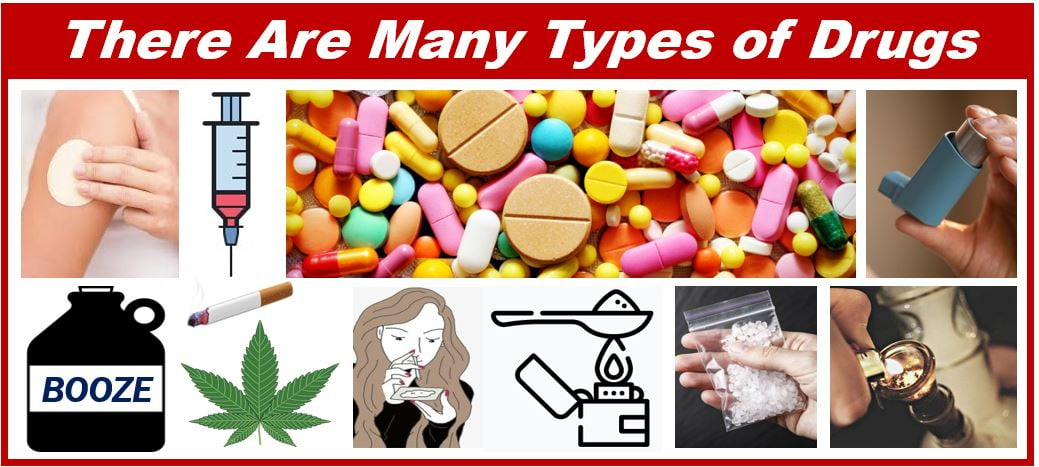A drug is a substance that when consumed by an organism causes a physiological or psychological change. An organism is a living being. We, for example, are organisms, as are other animals, bacteria, plants, and anything else that lives.
This article focuses on drugs as far as human beings are concerned, i.e., from our point of view.

In the world today, there are legal drugs, such as aspirin, prescription medications, caffeine, and alcohol (in most countries). There are also illegal drugs, such as heroin, crack, cocaine, ecstasy, LSD, and crystal meth.
There are some drugs which are used for general issues like weight gain or weight loss related problems. These are relevantly recently researched drugs which seem to be quite effective. For instance, the evidence in multiple studies on phentermine drug have shown to block the hormones responsible for hunger and appetite which results in effective weight loss.
HealthEngine has the following definition of the term:
“A drug is a chemical that interacts with proteins in the body to affect a physiological function. This is the general idea behind all medicine. Once these chemicals are absorbed into the systemic circulation they bind with certain proteins and this changes the functioning of the cell slightly.”
Drug consumption
We consume drugs in a variety of ways. Let’s have a look at some of them:
Inhalation
If you inhale something, you breathe it in. Tobacco smokers who are addicted get their nicotine by breathing it in, i.e., smoking.
Absorption via a patch
A skin patch or dermal patch is an adhesive that contains medication (a drug). The patient places it on the skin.
Ingestion
Ingestion, in this context, means taking the medication by either eating or drinking it – swallowing it.
Smoking
Some people consume marijuana (cannabis) by lighting it up and inhaling the smoke. Smoking is a type of inhalation.
Injection
The healthcare professional or patient uses a syringe with a hollow hypodermic needle which penetrates the skin. The drug is pushed through the needle into the person’s bloodstream.
Suppository
Rectal suppositories go into the rectum or anus, while we place vaginal ones inside the vagina. Urethral suppositories are sometimes used for male patients. The urethra is the tube through which urine passes until it leaves the body.
Dissolution under the tongue
With sublingual administration, the drug diffuses into the bloodstream through the mucous tissue below the tongue.
Intranasal use
Intranasal means through the nostrils, in other words, by snorting. Cocaine users, for example, typically snort it in powder form.
Etymology of the word drug
Etymology is the study of words and where they came from. Etymologists also study how the meanings of words evolved over time.
According to etymonline.com, the term first appeared in the English language in the late fourteenth century as the word Drogge. It was an Anglo-French word that meant “any substance used in the preparation or composition of medications.” It came from the Old French word Droge, which meant “supply, provision, stock.”
Nobody is sure where the Old French word came from. Maybe from the Middle-Low German or Middle Dutch word Droge-Vate, which meant “dry barrels.”
In the late nineteenth century, the term began to also refer to “opiates or narcotics,” i.e., substances that can make the consumer high or stoned.
Drug contents – what is in them?
Active ingredient
The substance in a medication that has the desired therapeutic effect its the active ingredient. In most cases, the active ingredient makes up a very small part of a tablet, pill, capsule, or suspension liquid.
Collinsdictionary.com has the following definition of active ingredient:
“The part of a substance or compound that produces its chemical or biological effect.”
Excipient – inactive ingredient
If the active ingredient is too small on its own to package, handle, or even see in a single dose, it must be held in inactive ingredients. In the world of pharmaceuticals and pharmacology, we call these inactive ingredients excipients.
Put simply, active ingredients are responsible for the medication’s activity while excipients fill out the drug so that we can handle it.
Wikipedia.org says the following about the word excipient:
“An excipient is a substance formulated alongside the active ingredient of a medication, included for the purpose of long-term stabilization, bulking up solid formulations that contain potent active ingredients in small amounts (thus often referred to as ‘bulking agents’, ‘fillers’, or ‘diluents’), or to confer a therapeutic enhancement on the active ingredient in the final dosage form, such as facilitating drug absorption, reducing viscosity, or enhancing solubility.”
Addiction
Addiction, in this article, refers to the condition of being dependent or addicted to a substance. If you have an addiction, you have a chronic physiological and maybe also psychological need for a substance or drug.
If a medication can cause dependency, we say that it is addictive.
This quote comes from one of our previous articles:
“Some addictive compounds can trigger significant and harmful changes in how the human brain functions. Even when the effects of the substance have gone, these changes may continue for a long time.”
“According to the UK’s National Health Service (NHS), you do not necessarily have to be taking a substance every day to have an addiction problem. If you have attempted to stop, for example, taking cocaine, but don’t or can’t, that is a sign of addiction.”
